How To Get Rid Of A Poison Ivy Rash Overnight
Though the rash won't disappear immediately, you can ease some discomfort right away.
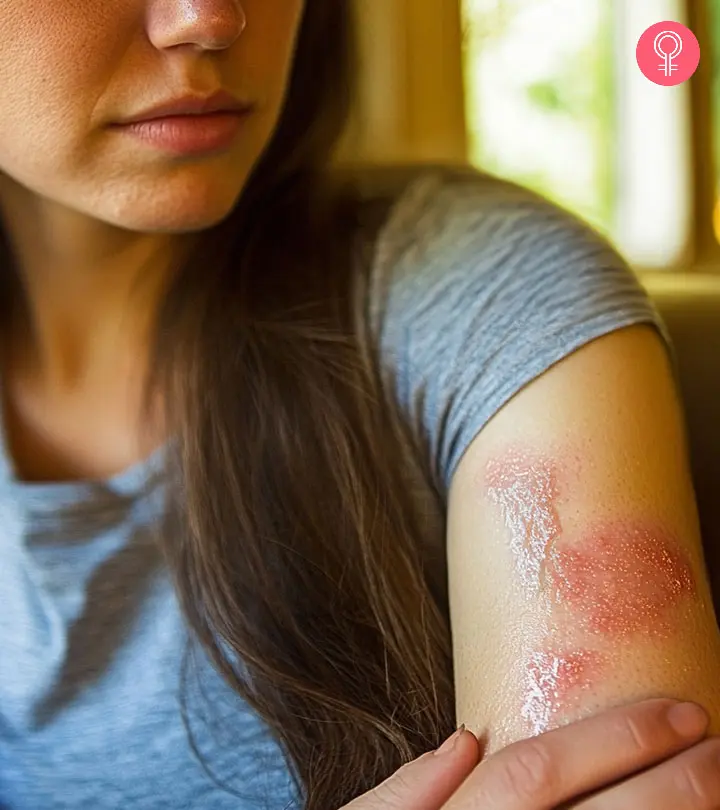
Image: Midjourney/ StyleCraze Design Team
If you see red and itchy rashes on your skin after working in your garden, you most likely have a poison ivy rash. This condition develops due to contact with urushiol, the oil produced by the poison ivy plant. When clearing overgrown areas or hiking through forest paths, many people come into contact with poison ivy and find a rash developing later. While the rashes go away on their own in a few days, there are a few quick solutions that can help you get rid of a poison ivy rash overnight. In this article, we dive deeper into the causes and symptoms of poison ivy rash and natural remedies you can try at home.

In This Article
What Is A Poison Ivy Rash?
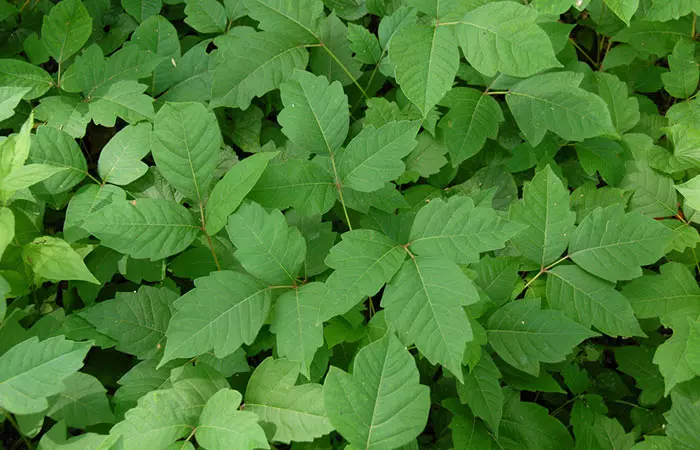
Poison ivy is a climbing plant that secretes an irritant oil from its leaves. Allergic reaction to this irritant oily resin (called urushiol) results in rashes.
A rash that results from contact with poison ivy often looks like a straight line because of the way it brushed against your skin. The severity of the rash depends on how much urushiol you have managed to get on your skin.
Toxicodendron oil or oleoresin, known as urushiol, causes skin responses in around 50%-75% of the adult population in the United States. A study conducted found that this poisonous plant-induced dermatitis poses an occupational hazard for US military personnel stationed in endemic areas. Over 11 years, 73,725 cases were diagnosed, with higher rates in male, young, non-Hispanic white service members, Army/Marine Corps personnel, and combat-related occupations. Summer months saw the majority of cases, with Fort Benning, Camp Pendleton, Fort Bragg, and Fort Campbell reporting significant diagnoses.
The factors that can cause or increase your risk of developing a poison ivy rash are as discussed below.
Key Takeaways
- Poison ivy rash is a condition that leads to skin rash and itching caused by contact with the oil called “urushiol” released by the poison ivy plant.
- Try natural and efficient home remedies to treat the condition such as oatmeal baths, neem oil, aloe vera, lemon juice, apple cider vinegar, etc.
- Understand how to identify the plants so you can avoid them.
- Remember to apply a barrier cream whenever there is a chance of coming into contact with the poisonous plant.
Causes And Risk Factors Of A Poison Ivy Rash
You can develop a poison ivy rash from the following:
- Direct contact with any part of the poison ivy plant
- Touching objects contaminated with the oily resin from poison ivy
- Inhaling smoke from burning poison ivy plants
Some outdoor activities that can increase your risk of developing plant allergies like a poison ivy rash are:
- Farming
- Landscaping
- Forestry
- Gardening
- Camping
- Fishing
- Hunting
Once your skin is exposed to urushiol, it can result in the following signs and symptoms.
Signs And Symptoms
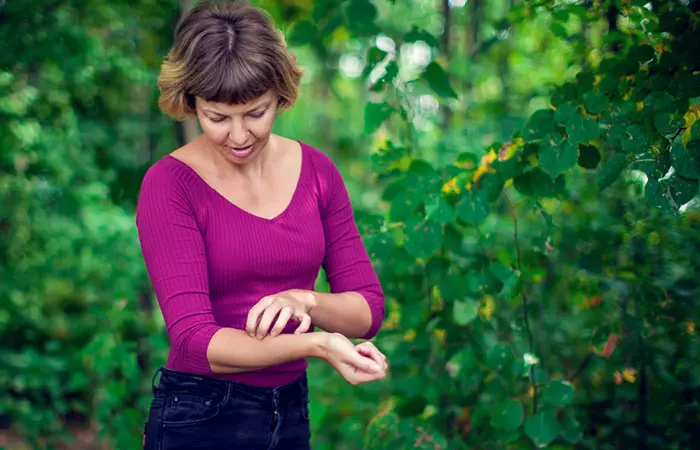
When your skin comes in contact with poison ivy, it may become:
- Red
- Swollen
- Blistered
- Itchy
In addition to this, you may also face difficulty in breathing if you inhale the smoke from burning poison ivy.
Dr. Harikiran Chekuri says, “It goes without saying, but the first instinct is usually to scratch, and that’s the worst thing you can do. Scratching doesn’t just break the skin; it actually triggers more histamine release, which makes the itch feel even worse. It’s a cycle that can turn a mild rash into a full-blown irritation.”
A poison ivy rash typically progresses through several stages and the symptoms may worsen over time. Find out in the next section.
Poison Ivy Rash Stages
According to the American Academy of Dermatology, a poison ivy rash takes 2-3 weeks to appear if you have never had it before (1). Here are the stages in which it progresses:
- Stage 1: You experience intense itching that can wake you from a sound sleep.
- Stage 2: You develop a red, blistering rash shortly after the itching starts.
- Stage 3: Once the blisters develop, they eventually break and leak fluid.
- Stage 4: The blisters crust over after the fluid leaks out.
The rash may clear within 2-3 weeks if you take the proper measures. However, you may experience itchiness till it clears completely.
Dr. Chekuri adds, “One of the biggest misconceptions is that the rash itself is contagious. It’s not. What spreads the rash is urushiol, the oil from the plant. That oil can stick to your skin, clothing, shoes, even pet fur, and stay active for weeks. I’ve had patients who kept breaking out because they didn’t realize their bedsheets or phone screen were still contaminated. “
He continues, “People should also know how delayed the reaction can be. Unlike a typical skin irritation, poison ivy is a delayed hypersensitivity reaction, which means you might not even see a rash until two or three days after exposure. That’s why some people think it’s spreading when really, different areas are just reacting at different times.”
Shawnda Dorantes, MSN, APRN, FNP-C, says, “Poison ivy is almost like nature’s way of reminding us that not all greenery is good for your skin! The key to stopping the rash from spreading is washing the area immediately after contact, using soap and cool water. And whatever you do, resist the scratch, scratching will just make it spread!”
A poison ivy rash can be difficult to get rid of, and it might also spread to other parts of your body if you don’t manage to get its resin off you soon. To prevent it from spreading further and treat the existing rashes, we have come up with a list of the best home remedies, which can be of great help. Read through to know how to get rid of poison ivy rash overnight naturally.
Effective Home Remedies To Treat Poison Ivy Rash
Dr. Chekuri says, “The best way to stop the rash from getting worse is to wash the skin immediately and not just with regular soap. Since urushiol is an oil, using dish soap, rubbing alcohol, or even a clay-based mask can help lift it off better.”
1. Oatmeal Bath

You Will Need
- 1 cup of powdered oatmeal
- Bathwater
What You Have To Do
- Add a cup of powdered oatmeal to a tub filled with water.
- Soak in the water for 20 to 30 minutes.
- You can also place some powdered oats in a muslin cloth and replace your loofah with it.
How Often You Should Do This
You must do this at least once daily.
Why This Works
Oatmeal possesses antioxidant and anti-inflammatory properties that can help in relieving the itching and inflammation associated with a poison ivy rash almost instantly (2),
A review published in the Indian Journal of Dermatology, Venereology, and Leprology (2012) highlights the potential benefits of oatmeal in dermatology. The study revealed that oatmeal has antioxidant and anti-inflammatory properties and could be effective in treating various skin conditions, including pruritus (itching), atopic dermatitis, acne-like eruptions, and viral skin infections (3).
2. Baking Soda
You Will Need
- 2 teaspoons of baking soda
- 2 glasses of water
- Sterile gauze pads
What You Have To Do
- Mix two teaspoons of baking soda with two glasses of water.
- Soak a few gauze pads in this solution.
- Place them over the rashes and leave them on for 10 minutes.
- Remove the gauze pads and wash the remnants off your skin.
How Often You Should Do This
Do this 3 to 4 times daily for a few days.
Why This Works
Baking soda is alkaline and has pH neutralizing properties
. It helps restore the pH of your blistered skin and promotes healing of the rashes. The antibacterial properties of baking soda protect the rashes from further infection (4). This remedy can come in handy if you are also looking for home remedies for skin itching caused by poison ivy rash.
3. Apple Cider Vinegar
You Will Need
- 2 tablespoons of apple cider vinegar
- 1-2 glasses of water
- Sterile gauze pads
What You Have To Do
- Add two tablespoons of apple cider vinegar to two glasses of water.
- Mix well and soak a few gauze pads in this solution. Place them over the rashes.
- over the rashes.
- Leave them on for 5 to 10 minutes.
- Remove the gauze pads and wash off any remnants.
How Often You Should Do This
You can do this 2 to 3 times daily.
Why This Works
Given its acidic, anti-inflammatory, and antimicrobial properties, ACV is one of the best options for treating a poison ivy rash (5).
4. Bleach
You Will Need
- 1/4 cup of household bleach
- Bathwater
What You Have To Do
- Add one-fourth cup of bleach to your bathwater and mix well.
- Soak in it for 20 to 30 minutes.
- You can also spray some bleach on the poison ivy plant to kill it.
How Often You Should Do This
You must do this as soon as you come in contact with poison ivy for best results.
Why This Works
Bleach contains chlorine, a natural disinfectant that tends to dry out your skin.
The disinfecting and drying properties of bleach can soothe the itch and speed up the healing of the poison ivy rash (6).
Caution
If you have sensitive skin, avoid this remedy as it might cause a burning sensation.
5. Jewelweed
You Will Need
Crushed jewelweed plant
What You Have To Do
- Crush the stems of the jewelweed plant to form a paste.
- Apply this paste over the rashes.
- Allow it to dry and then wash it off with water.
How Often You Should Do This
You must do this twice daily for a few days.
Why This Works
Jewelweed is popularly known as the touch-me-not plant. It contains saponins that help in drying the liquid-filled blisters and soothe the itching and inflammation (7), (8).
6. Banana Peel

You Will Need
1 banana peel
What You Have To Do
- Rub a banana peel over the affected areas.
- Leave it on for 10 to 15 minutes before washing it off with water.
How Often You Should Do This
You can repeat this remedy 2 to 3 times in a day.
Why This Works
Banana
peels are quite popular for their antimicrobial and anti-inflammatory properties. They help in soothing the itching and inflammation that accompany a poison ivy rash and protect your skin from further infection. A study published in the Journal of the Medical Association of Thailand (2012) investigated the anti-inflammatory and antioxidant properties of banana (Musa sapientum) peel extract that is traditionally used in Thai medicine. Using various extraction methods, researchers found that the water extract of fresh ripe peel was the most effective at reducing inflammation, while the decoction extract of fresh unripe peel showed strong antioxidant activity and the highest phenolic content. The results highlight the potential of banana peel as a natural remedy for inflammatory-related conditions, supporting its traditional use in Thai medicine (9).
7. Toothpaste
You Will Need
Toothpaste (as required)
What You Have To Do
- Take a little toothpaste on your fingers and dab it on the affected areas.
- Allow it to dry before washing it off with water.
How Often You Should Do This
You must do this 2 to 3 times daily until there are no traces of the rash.
Why This Works
Toothpastes (especially the mint-flavored ones) exhibit exceptional soothing and cooling properties. The glycerin in the toothpaste helps in drying up the rash and speeds up its healing (9). It also reduces inflammation and redness.
8. Essential Oils
a. Tea Tree Oil
You Will Need
- 2-3 drops of tea tree oil
- 1 tablespoon of any carrier oil (coconut or olive oil)
What You Have To Do
- Add two to three drops of tea tree oil to any carrier oil and mix well.
- Apply this mixture to the affected areas.
- Leave it on for 15 to 20 minutes and then take a bath.
How Often You Should Do This
You must do this at least once daily for a few days.
Why This Works
Tea tree oil reduces inflammation and prevents infection in the affected areas due to its anti-inflammatory and antimicrobial properties (10), (11). It also eliminates pain, if any, and promotes faster healing of the rashes.
b. Peppermint Oil
You Will Need
- 3-4 drops of peppermint oil
- 1 tablespoon of any carrier oil (coconut or jojoba oil)
What You Have To Do
- Add three to four drops of tea tree oil to a tablespoon of any carrier oil.
- Mix well and apply it to the affected area.
- Leave it on for 15 to 20 minutes and then wash it off with water.
How Often You Should Do This
Do this twice daily for a week or two.
Why This Works
Peppermint oil is one of the best essential oils for treating a poison ivy rash. It contains antioxidants and an active compound called menthol, both of which help in soothing the rash (12).
9. Coconut Oil
You Will Need
Coconut oil (as required)
What You Have To Do
- Take a little coconut oil on your fingers and apply it to the rashes.
- Leave it on and let it be absorbed by your skin.
How Often You Should Do This
You must apply coconut oil 2 to 3 times daily for a few days.
Why This Works
The anti-inflammatory, analgesic, and antifungal properties of coconut oil soothe and relieve the itching and the pain and also speed up your recovery (13), (14), (15).
10. Epsom Salt
You Will Need
- 1 cup of Epsom salt
- Water
What You Have To Do
- Add a cup of Epsom salt to your bath.
- Soak in it for 20 to 30 minutes.
How Often You Should Do This
You must do this once daily for a week or two.
Why This Works
Epsom salt contains magnesium, which imparts anti-inflammatory properties to it (16). This magnesium is absorbed by the skin, which reduces inflammation and promotes healing (17).
11. Aloe Vera
You Will Need
Aloe vera gel (as required)
What You Have To Do
- Apply a little aloe vera gel to the affected areas.
- Allow it to dry and reapply as required.
How Often You Should Do This
Apply aloe gel multiple times a day for a few days.
Why This Works
Aloe vera contains active compounds that have healing, soothing, antifungal, and anti-inflammatory properties, which can treat a poison ivy rash (18), (19). A study published in the Journal of Ethnopharmacology explored how Aloe vera gel extracts can help reduce inflammation. Researchers tested three types of extracts—aqueous (water-based), chloroform, and ethanol—on rats with swelling caused by carrageenan. The aqueous and chloroform extracts reduced swelling and the movement of inflammatory cells, while the ethanol extract mainly reduced cell movement. The water-based extract also blocked the production of prostaglandin E2, a substance that triggers inflammation. This study shows that compounds in Aloe vera gel have strong anti-inflammatory effects (20). Since it is popular among the most used home remedies for allergies, it may also help reduce redness and soothe the skin.
12. Lemon Juice
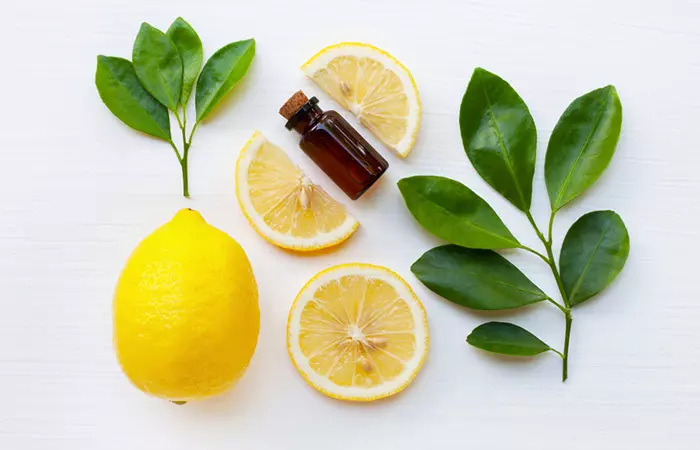
You Will Need
- 1 teaspoon of lemon juice
- 1 tablespoon of any carrier oil (coconut or olive oil)
What You Have To Do
- Mix a teaspoon of lemon juice with any carrier oil.
- Apply this to the rash.
- Leave it on for 10 to 15 minutes and then wash it off with water.
How Often You Should Do This
You can do this once every alternate day for a week or two.
Why This Works
The acidic nature of lemon juice can help neutralize the pH of your blistered skin, thereby helping it to dry faster. Lemon is also a rich source of vitamin C, which has anti-inflammatory properties and can help in reducing the itching, inflammation, and swelling (21).
13. Neem Oil
You Will Need
- 1 teaspoon of neem oil
- Any carrier oil (optional)
What You Have To Do
- Apply a little neem oil to the affected area and leave it on for 20 to 30 minutes.
- leave it on for 20 to 30 minutes.
- Wash it off with water.
- If you have sensitive skin, mix neem oil with a carrier oil of your choice before applying it.
How Often You Should Do This
You must do this 1 to 2 times daily for a week.
Why This Works
Neem oil is another option that you can consider for getting rid of a poison ivy rash at the earliest. Its anti-inflammatory properties help in relieving itching, irritation, inflammation, and redness (22). Neem oil also possesses antiseptic properties that protect the rash from infection.
 Quick Tip
Quick TipJanine Bandcroft, a blogger, discusses recurring bouts of poison oak rash, possibly linked to childhood exposures. She discussed how treating poison oak bouts with natural remedies helped her the best. She writes, “If you suspect they might be, or if you just want to be sure they aren’t, make a paste of slippery elm bark and cover the affected area. Let that sit for about 15 minutes and rinse. Slippery elm bark is good for drawing thistles and splinters and thorns out of your body. It also helps ease the itch. (i)”. She also shares a few more remedies such as avoiding heat, drinking chamomile tea to manage inflammation, and soaking in a detoxifying bath.
Dr. Chekuri says, “Once the rash is there, keeping the skin calm is key. Astringents like aloe vera or diluted vinegar can help dry out blisters, but over-drying can actually make things worse by causing tiny cracks in the skin. Hydrocortisone creams, antihistamines, and even stress management play a role because believe it or not, elevated cortisol levels can actually make inflammation worse.”
A poison ivy rash usually lasts for two to three weeks. But with proper treatment, it can disappear sooner. You can also take the following precautionary measures to prevent the recurrence of such rashes.
Prevention Tips
- Learn to identify poisonous plants and steer clear of them.
- Wear protective clothing if you are in surroundings that increase your risk of developing a poison ivy rash.
- Remove or destroy any such plants that you come across. However, do not burn them.
- Wash your hands, your pet, and any other object that may have come in contact with poison ivy within 30 minutes of exposure to reduce the intensity of the rash.
- Avoid scratching the area to prevent further irritation and possible infection.
- Apply a barrier cream whenever there is a risk of coming in contact with poison ivy.
, a double board-certified dermatologist and a Fellow of the American Academy of Dermatology, says, “It’s preferable to leave it exposed as much as possible.”
Although you can lessen your chance of getting poison ivy by following practical preventative advice, it is important to know when to get medical attention if you get a serious rash. Scroll down to learn more.
When To Seek Medical Help
If you experience severe symptoms including breathing difficulties, face, lip, or throat swelling, or if the rash covers a significant portion of your body, get medical attention. It is also important to see a doctor if you get a high fever, any infection-related symptoms including increased redness, pus, or pain, or if the rash does not go away with over-the-counter remedies.
Infographic: What Not To Do When You Get Poison Ivy Rash
Poison ivy rash may not disappear as easily as you think. It may get worse if you have more urushiol on your skin. If not treated on time, the rash can also spread to other parts of the body. While you must know what you need to do to get rid of the rash, you also should be aware of what you should not do. The infographic below discusses the same in detail. Check it out! Illustration: StyleCraze Design Team
 Quick Tip
Quick TipCertain natural remedies can help one get rid of a poison ivy rash overnight. Baking soda, apple cider vinegar, bleach, oatmeal bath, and jewelweed work effectively. In addition, toothpaste, banana peel, essential oils, coconut oils, Epsom salt, aloe vera, lemon juice, and neem oil help manage poison ivy rash. If the symptoms persist, visit a healthcare expert. Doctors usually prescribe antihistamines and corticosteroids for poison ivy dermatitis relief (23) (24). Identifying poisonous plants, clearing them, and washing hands and all other objects that come into contact with poison ivy can help reduce the risk of the rash. Applying barrier topical creams when there is a risk of poison ivy reduces the risk of infection. We hope now you know how to get rid of poison ivy in one day or overnight by following these simple remedies.
Frequently Asked Questions
Will hydrogen peroxide dry up poison ivy?
Dr. Chacon says, “Hydrogen peroxide can aid in the treatment of poison ivy rash.”
Does salt water dry up poison ivy?
According to Dr. Anna Chacon, “The sea salt helps to dry up the rash, allowing it to recover faster.”
Does sweating make poison ivy worse?
Dr. Chacon states that if the resin (urushiol) has been wiped away, perspiration will not spread the rash.
How long does it take for a poison ivy rash to go away?
The resin from poison ivy can enter your skin within 5 to 10 minutes of contact. However, it may take anywhere between 4 hours to 2 weeks for the rashes to appear. These rashes usually last for a week or two, but in severe cases, they can last for 30 days or longer.
Does poison ivy rash spread from person to person?
Poison ivy rash isn’t contagious, and the blisters that appear as a result of contact with it do not contain urushiol. Hence, they do not spread from person to person. However, if you come in contact with its oil irritant resin directly or via other objects, you can develop a poison ivy rash.
Will hydrogen peroxide dry up poison ivy?
Yes, you can use a 3% hydrogen peroxide solution to help dry up your poison ivy rash. However, be cautious, as it may even irritate the rash further. Consult your doctor before using this remedy for treating your poison ivy rash.
Is the Dawn dish soap good for poison ivy?
Anecdotal evidence suggests that the Dawn detergent soap will help break up urushiol, the oil responsible for the development of poison ivy. You can apply a few drops of the dish soap directly to the skin or wrap a fresh cloth around it and apply it to the affected areas.
Why is poison ivy spreading after a week?
The poison ivy rash may spread even after a week if the different exposed areas absorb the chemical at different rates. Even repeated exposure of the affected areas to the contaminated objects may cause the rash to spread further.
Applying alcohol on an ulcerative rash would slow down the healing process.
Watch the video below for some simple steps to treat your poison ivy rash. It also shares tips on soothing the itch and reducing the accompanying inflammation.
Personal Experience: Source
StyleCraze's articles are interwoven with authentic personal narratives that provide depth and resonance to our content. Below are the sources of the personal accounts referenced in this article.
i. How I Survived Poison Oak/Ivyhttps://janinebandcroft.blogspot.com/2012/09/how-i-survived-poison-oakivy.html
References
Articles on StyleCraze are backed by verified information from peer-reviewed and academic research papers, reputed organizations, research institutions, and medical associations to ensure accuracy and relevance. Read our editorial policy to learn more.
- Poison ivy, oak, and sumac: what does the rash look like?
https://www.aad.org/public/everyday-care/itchy-skin/poison-ivy/what-rash-looks-like - Anti-inflammatory activities of colloidal oatmeal (Avena sativa) contribute to the effectiveness of oats in treatment of itch associated with dry, irritated skin
https://pubmed.ncbi.nlm.nih.gov/25607907/ - Oatmeal in dermatology: a brief review
https://pubmed.ncbi.nlm.nih.gov/22421643/ - Antibacterial activity of baking soda
https://pubmed.ncbi.nlm.nih.gov/12017929/ - Antibacterial apple cider vinegar eradicates methicillin resistant Staphylococcus aureus and resistant Escherichia coli
https://www.ncbi.nlm.nih.gov/pmc/articles/PMC7817673/ - Efficacy of bleach baths in reducing severity of atopic dermatitis: A systematic review and meta-analysis
https://www.ncbi.nlm.nih.gov/pmc/articles/PMC5726436/ - Efficacy of the saponin component of Impatiens capensis Meerb in preventing urushiol-induced contact dermatitis
https://pubmed.ncbi.nlm.nih.gov/25543019/ - The effectiveness of jewelweed, Impatiens capensis, the related cultivar I. balsamina and the component, lawsone in preventing post poison ivy exposure contact dermatitis
https://pubmed.ncbi.nlm.nih.gov/22766473/ - Anti-inflammatory and antioxidant activities of extracts from Musa Sapientum peel
https://pubmed.ncbi.nlm.nih.gov/23964457/ - Anti-inflammatory effects of Melaleuca alternifolia essential oil on human polymorphonuclear neutrophils and monocytes
https://pubmed.ncbi.nlm.nih.gov/15493453/ - Melaleuca alternifolia (Tea Tree) Oil: a Review of Antimicrobial and Other Medicinal Properties
https://www.ncbi.nlm.nih.gov/pmc/articles/PMC1360273/ - The effect of peppermint oil on symptomatic treatment of pruritus in pregnant women
https://www.ncbi.nlm.nih.gov/pmc/articles/PMC3813175/ - Anti-inflammatory, analgesic, and antipyretic activities of virgin coconut oil
https://pubmed.ncbi.nlm.nih.gov/20645831/ - In vitro evaluation of antifungal activity of monolaurin against Candida albicans biofilms
https://www.ncbi.nlm.nih.gov/pmc/articles/PMC4924139/ - In vitro antimicrobial properties of coconut oil on Candida species in Ibadan, Nigeria
https://pubmed.ncbi.nlm.nih.gov/17651080/ - Magnesium Decreases Inflammatory Cytokine Production: A Novel Innate Immunomodulatory Mechanism
https://www.ncbi.nlm.nih.gov/pmc/articles/PMC3884513/ - Myth or reality—transdermal magnesium?
https://www.ncbi.nlm.nih.gov/pmc/articles/PMC5579607/ - ALOE VERA: A SHORT REVIEW
https://www.ncbi.nlm.nih.gov/pmc/articles/PMC2763764/ - The Review on Properties of Aloe Vera in Healing of Cutaneous Wounds
https://www.ncbi.nlm.nih.gov/pmc/articles/PMC4452276/ - Antiinflammatory activity of extracts from Aloe vera gel
https://pubmed.ncbi.nlm.nih.gov/9121170/ - Anti-inflammatory effect of lemon mucilage: in vivo and in vitro studies
https://pubmed.ncbi.nlm.nih.gov/16435583/ - Therapeutics Role of Azadirachta indica (Neem) and Their Active Constituents in Diseases Prevention and Treatment
https://www.ncbi.nlm.nih.gov/pmc/articles/PMC4791507/ - Oral corticosteroids for poison ivy dermatitis
https://www.ncbi.nlm.nih.gov/pmc/articles/PMC99302/ - Poison ivy oak and sumac dermatitis identification, treatment, and prevention
https://pubmed.ncbi.nlm.nih.gov/20086717/
Read full bio of Dr. Hari Hara Sudhan
- Shawnda Dorantes, MSN, APRN, FNP-C, is the founder and Master Injector at Beauty Lounge Medical Spa. She has 15 years of experience in the beauty industry and 13 years as a registered nurse. Dorantes began her career as a Beauty Advisor for Estee Lauder. She later became a freelance professional makeup artist and then joined Estee Lauder’s Regional Artistry Team. After finishing her triple major in Biological Sciences, Women’s Studies, and Nursing from the Cal State San Marcos School of Nursing, she worked as a nurse in the acute care setting for over eight years. Dorantes then earned her Allergan Master injector certification and a master’s degree in Nursing. She specializes in injectables and skin care and also provides additional services like cryotherapy, medical management of acne, and medical weight loss, among others.
 Shawnda Dorantes, MSN, APRN, FNP-C, is the founder and Master Injector at Beauty Lounge Medical Spa. She has 15 years of experience in the beauty industry and 13 years as a registered nurse. Dorantes began her career as a Beauty Advisor for Estee Lauder. She later became a freelance professional makeup artist and then joined Estee Lauder’s Regional Artistry Team. After finishing her triple major in Biological Sciences, Women’s Studies, and Nursing from the Cal State San Marcos School of Nursing, she worked as a nurse in the acute care setting for over eight years. Dorantes then earned her Allergan Master injector certification and a master’s degree in Nursing. She specializes in injectables and skin care and also provides additional services like cryotherapy, medical management of acne, and medical weight loss, among others.
Shawnda Dorantes, MSN, APRN, FNP-C, is the founder and Master Injector at Beauty Lounge Medical Spa. She has 15 years of experience in the beauty industry and 13 years as a registered nurse. Dorantes began her career as a Beauty Advisor for Estee Lauder. She later became a freelance professional makeup artist and then joined Estee Lauder’s Regional Artistry Team. After finishing her triple major in Biological Sciences, Women’s Studies, and Nursing from the Cal State San Marcos School of Nursing, she worked as a nurse in the acute care setting for over eight years. Dorantes then earned her Allergan Master injector certification and a master’s degree in Nursing. She specializes in injectables and skin care and also provides additional services like cryotherapy, medical management of acne, and medical weight loss, among others. - Dr. Harikiran Chekuri, MS, is a board-certified plastic and cosmetic surgeon specializing in hair transplant, plastic surgery, and reconstructive and esthetic surgery. He has 20 years of experience, performed more than 15,000 plastic surgeries, and received over 24 awards for his expertise. Dr. Chekuri is an alumnus of JSS Medical College, Mysore, and the founder and director of ReDefine Hair Transplant & Plastic Surgery Centre, Hyderabad.
 Dr. Harikiran Chekuri, MS, is a board-certified plastic and cosmetic surgeon specializing in hair transplant, plastic surgery, and reconstructive and esthetic surgery. He has 20 years of experience, performed more than 15,000 plastic surgeries, and received over 24 awards for his expertise. Dr. Chekuri is an alumnus of JSS Medical College, Mysore, and the founder and director of ReDefine Hair Transplant & Plastic Surgery Centre, Hyderabad.
Dr. Harikiran Chekuri, MS, is a board-certified plastic and cosmetic surgeon specializing in hair transplant, plastic surgery, and reconstructive and esthetic surgery. He has 20 years of experience, performed more than 15,000 plastic surgeries, and received over 24 awards for his expertise. Dr. Chekuri is an alumnus of JSS Medical College, Mysore, and the founder and director of ReDefine Hair Transplant & Plastic Surgery Centre, Hyderabad. - Dr. Anna Chacon, MD, FAAD, is a double board-certified dermatologist with over 7 years of experience. She has authored many peer-reviewed articles and managed clinical research studies during her fellowship. She completed her medical school in the PLME (Program of Liberal Medical Education) at Brown University.
 Dr. Anna Chacon, MD, FAAD, is a double board-certified dermatologist with over 7 years of experience. She has authored many peer-reviewed articles and managed clinical research studies during her fellowship. She completed her medical school in the PLME (Program of Liberal Medical Education) at Brown University.
Dr. Anna Chacon, MD, FAAD, is a double board-certified dermatologist with over 7 years of experience. She has authored many peer-reviewed articles and managed clinical research studies during her fellowship. She completed her medical school in the PLME (Program of Liberal Medical Education) at Brown University.
Read full bio of Shaheen Naser
Read full bio of Ramona Sinha
Read full bio of Swathi E







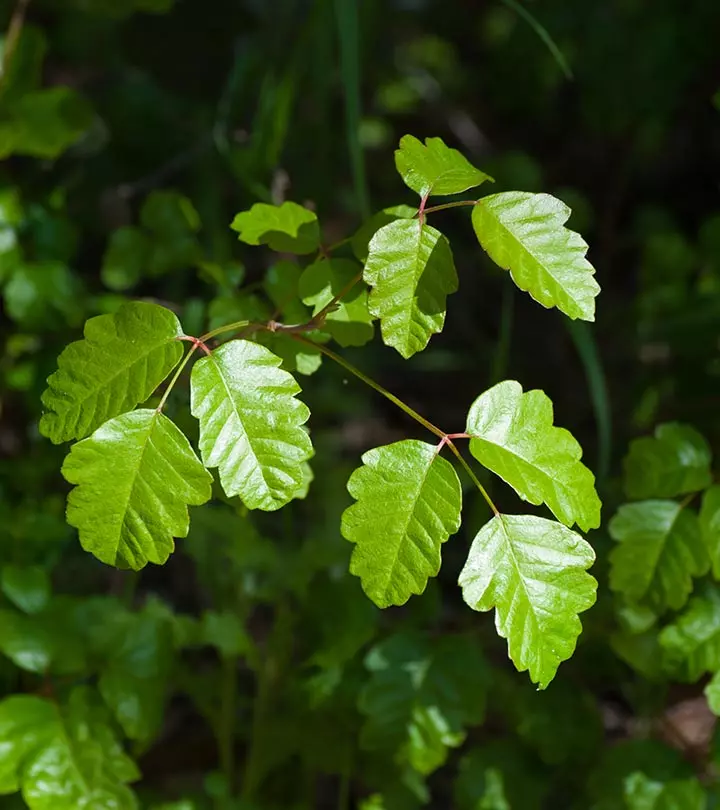
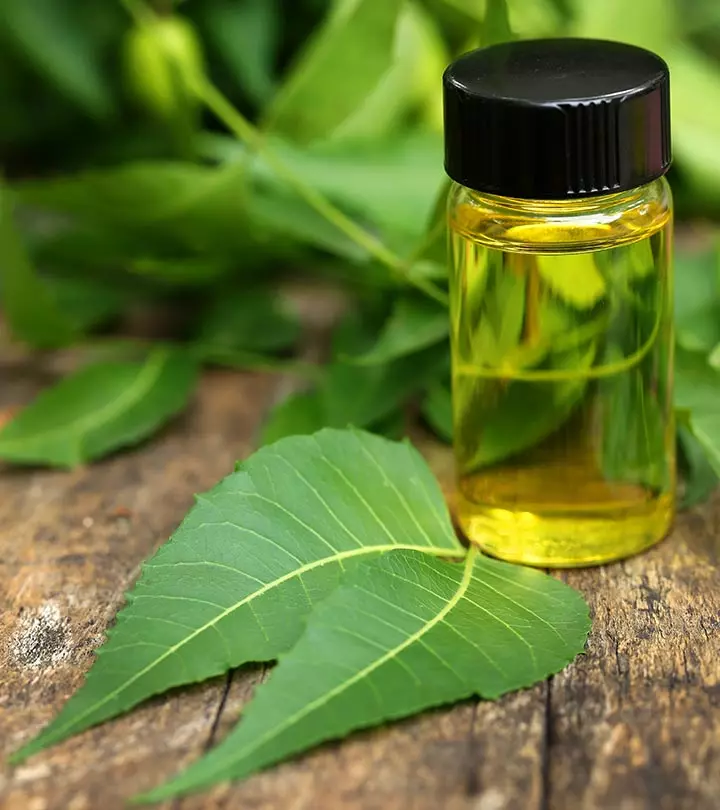
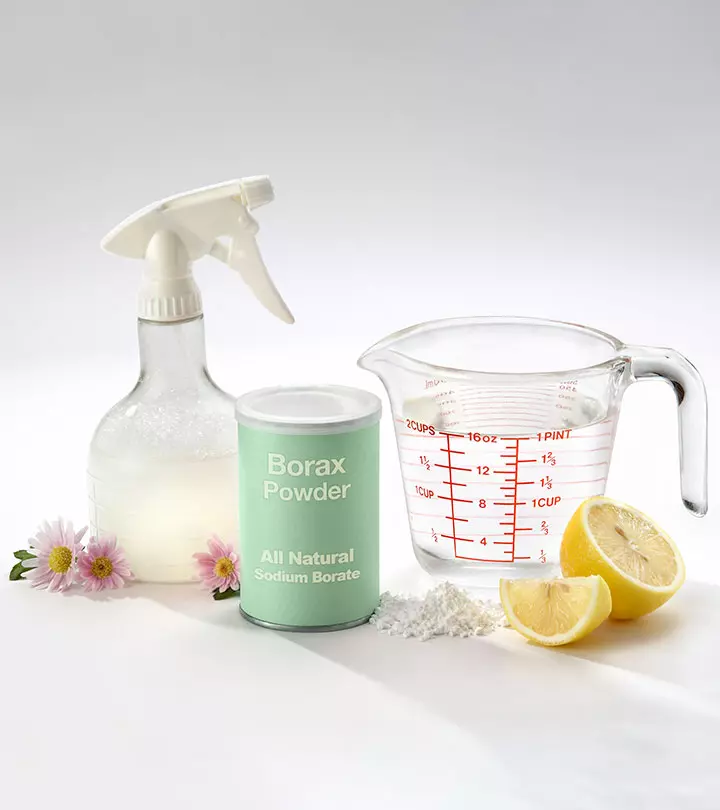

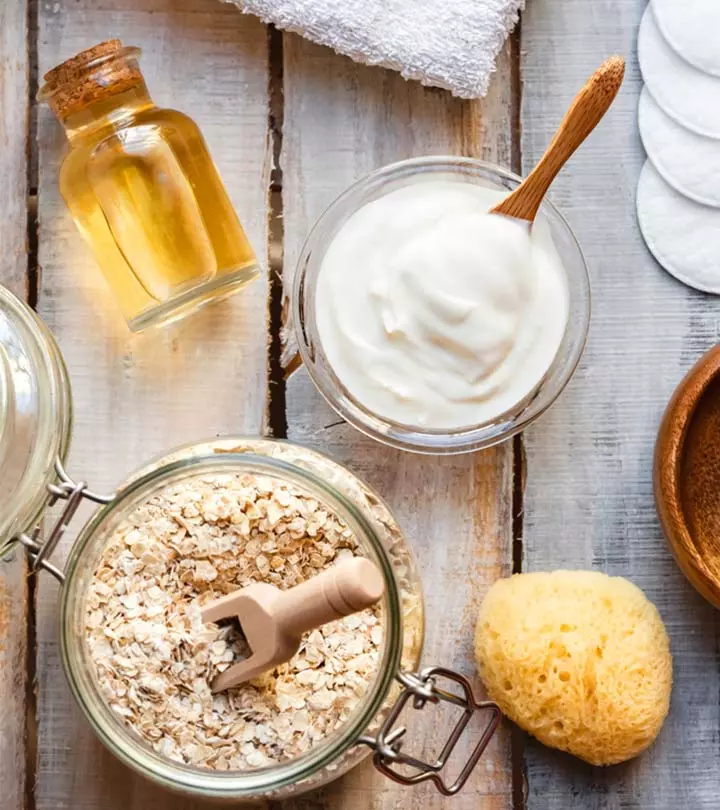
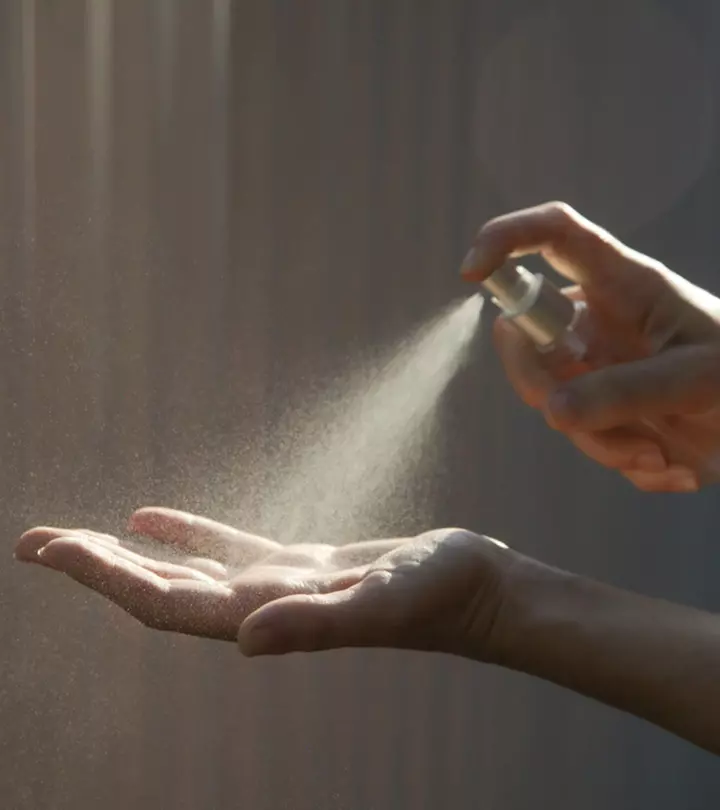
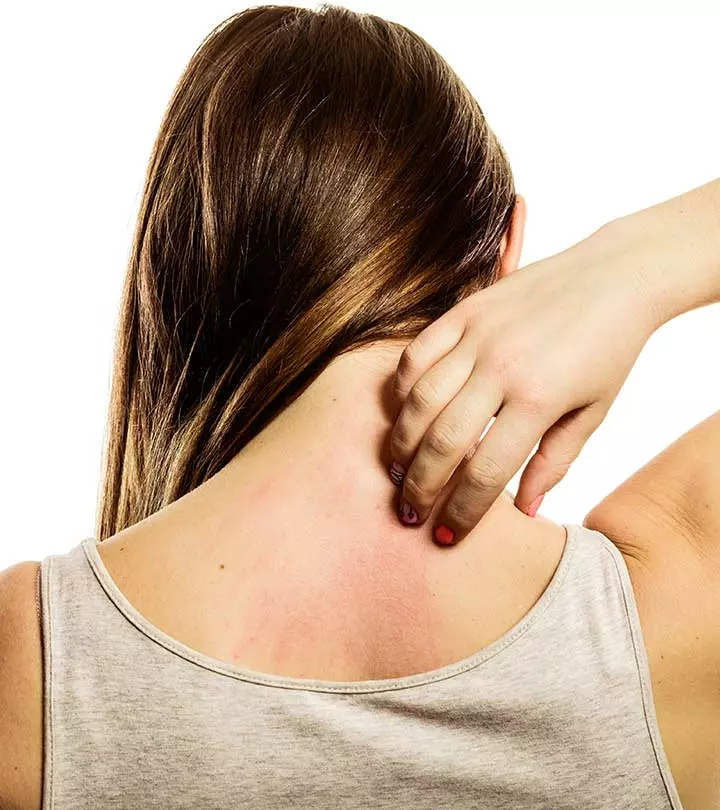
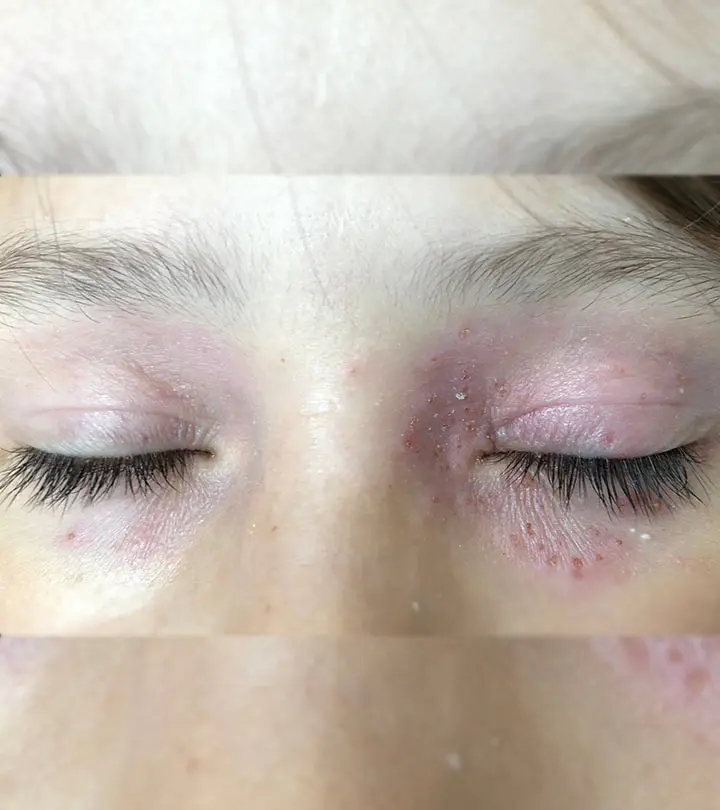





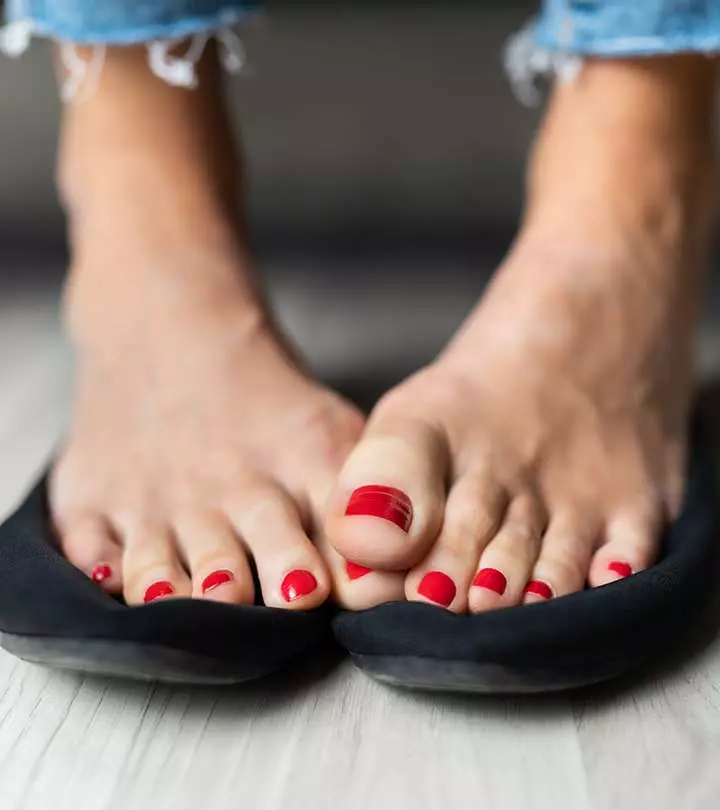



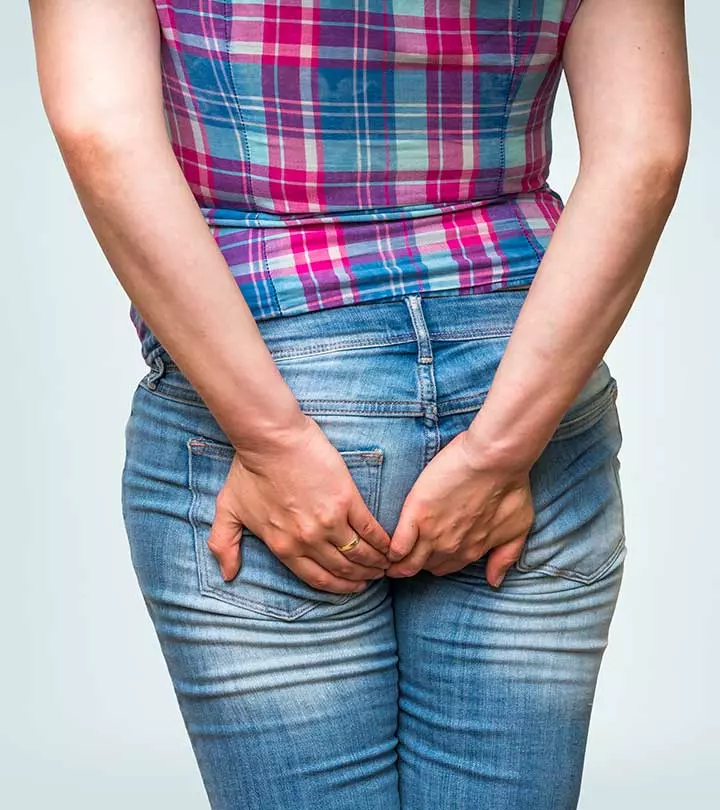



Community Experiences
Join the conversation and become a part of our empowering community! Share your stories, experiences, and insights to connect with other beauty, lifestyle, and health enthusiasts.